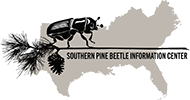Abstract
Interrelationships between the southern pine beetle (SPB), Dendroctonus frontalis
Zimm.) and its host pines are explained in terms of the growth–differentiation balance
concept. A general hypothesis is proposed based on growth–differentiation balance in
southern pines (radial growth of stems versus synthesis and yield of oleoreain) and seasonal
activity of the SPB based on knowledge from experimentation and observations
reported in the literature. The spring appears to be particularly favorable for successful
SPB attack because of the strong demand for available photosynthates by growth proceases
at that time, whereas, in the summer, strong resin flow increases the potential
resistance of trees to attack.
Growth–differentiation balance provides a basis for understanding SPB-tree interactions,
a rationale for commonly experienced problems in identifying consistent precursors
to SPB outbreaks, and a philosophical basis for future research. The concept has potential
application to other bark beetle–host conifer relationships.
